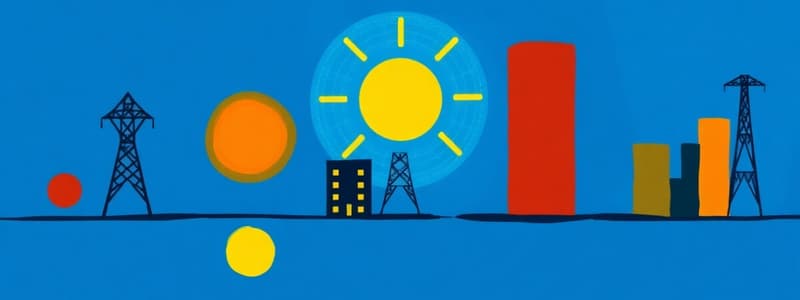Podcast
Questions and Answers
Which of the following is NOT a core principle of Demand Side Management (DSM)?
Which of the following is NOT a core principle of Demand Side Management (DSM)?
- Load Growth (correct)
- Load Shifting
- Strategic Load Reduction
- Peak Shaving
What was the primary objective of the early DSM research programs launched in the 1980s?
What was the primary objective of the early DSM research programs launched in the 1980s?
- To increase the efficiency of power generators.
- To improve the reliability of electricity distribution networks.
- To modify user load patterns over time. (correct)
- To develop new technologies for renewable energy sources.
What technique involves intentionally reducing electricity consumption during peak demand periods?
What technique involves intentionally reducing electricity consumption during peak demand periods?
- Strategic Load Growth
- Load Shifting
- Valley Filling
- Peak Shaving (correct)
What is the goal of "valley filling" within DSM?
What is the goal of "valley filling" within DSM?
The term "strategic load reduction" refers to:
The term "strategic load reduction" refers to:
What is the common characteristic that 'load control', 'interruptible/curtailable load programs', and 'demand bidding' share?
What is the common characteristic that 'load control', 'interruptible/curtailable load programs', and 'demand bidding' share?
Which type of demand response program involves users offering to reduce their load in various types of markets?
Which type of demand response program involves users offering to reduce their load in various types of markets?
What is the defining characteristic of 'market-based' demand response programs?
What is the defining characteristic of 'market-based' demand response programs?
Which of the following is NOT an example of an ancillary service that can be provided by demand response programs?
Which of the following is NOT an example of an ancillary service that can be provided by demand response programs?
Which of the following statements BEST describes the concept of Demand Response?
Which of the following statements BEST describes the concept of Demand Response?
Which of the following tariff structures is characterized by varying rates defined immediately before the consumption instant?
Which of the following tariff structures is characterized by varying rates defined immediately before the consumption instant?
What is the primary goal of Time-Of-Use (TOU) rates?
What is the primary goal of Time-Of-Use (TOU) rates?
Which load management strategy involves deliberate power outages implemented by the System Operator to address emergencies?
Which load management strategy involves deliberate power outages implemented by the System Operator to address emergencies?
What differentiates Real-Time Pricing (RTP) from Time-Of-Use (TOU) tariffs?
What differentiates Real-Time Pricing (RTP) from Time-Of-Use (TOU) tariffs?
Which load management strategy relies on voluntary consumer participation in response to price incentives?
Which load management strategy relies on voluntary consumer participation in response to price incentives?
Which of the following is an example of a controllable load that can be easily adjusted by altering thermostat settings?
Which of the following is an example of a controllable load that can be easily adjusted by altering thermostat settings?
What is the primary characteristic of 'deferrable loads'?
What is the primary characteristic of 'deferrable loads'?
Which type of load can be partially or fully curtailed without requiring re-activation later?
Which type of load can be partially or fully curtailed without requiring re-activation later?
What is the main goal of Direct Load Control (DLC)?
What is the main goal of Direct Load Control (DLC)?
Which load management strategy typically utilizes a combination of price incentives and automatic control mechanisms?
Which load management strategy typically utilizes a combination of price incentives and automatic control mechanisms?
Which of the following is a characteristic of deferrable appliances?
Which of the following is a characteristic of deferrable appliances?
Which appliance category is an example of a non-flexible deferrable appliance?
Which appliance category is an example of a non-flexible deferrable appliance?
Which type of appliance can be fully curtailed?
Which type of appliance can be fully curtailed?
What is the role of the optimization engine in the Home Energy Management System (HEMS)?
What is the role of the optimization engine in the Home Energy Management System (HEMS)?
What consumer preference is considered when determining the operation of flexible deferrable appliances?
What consumer preference is considered when determining the operation of flexible deferrable appliances?
Which of the following is NOT an aspect of consumer preferences considered for appliance operation?
Which of the following is NOT an aspect of consumer preferences considered for appliance operation?
How does the HEMS modify the consumer profile?
How does the HEMS modify the consumer profile?
What is the primary objective of the Automated Demand Response (ADR) system in the context of the HEMS?
What is the primary objective of the Automated Demand Response (ADR) system in the context of the HEMS?
What is a key factor in achieving success with demand response services?
What is a key factor in achieving success with demand response services?
Why might users participate in a demand response program?
Why might users participate in a demand response program?
What is the role of an aggregator in demand response?
What is the role of an aggregator in demand response?
What is a key consideration for ensuring the success of demand response programs?
What is a key consideration for ensuring the success of demand response programs?
What is essential for verifying the effectiveness of demand response programs?
What is essential for verifying the effectiveness of demand response programs?
What is a potential benefit of demand-side participation in electricity markets?
What is a potential benefit of demand-side participation in electricity markets?
Who can act as an aggregator in the demand response system?
Who can act as an aggregator in the demand response system?
Which of the following is NOT a factor inhibiting the development of Demand Response (DR) programs in Europe?
Which of the following is NOT a factor inhibiting the development of Demand Response (DR) programs in Europe?
What is a key barrier to the widespread adoption of Demand Response (DR) services by consumers in Europe?
What is a key barrier to the widespread adoption of Demand Response (DR) services by consumers in Europe?
What is the predicted baseline in a Demand Response (DR) program?
What is the predicted baseline in a Demand Response (DR) program?
What is a key recommendation for improving the effectiveness of Demand Response (DR) markets in Europe, according to the Smart Energy Demand Coalition Report (2017)?
What is a key recommendation for improving the effectiveness of Demand Response (DR) markets in Europe, according to the Smart Energy Demand Coalition Report (2017)?
What does the concept of 'balancing markets' refer to in the context of Demand Response (DR)?
What does the concept of 'balancing markets' refer to in the context of Demand Response (DR)?
Which of the following is NOT a method used to determine the predicted baseline in a Demand Response program?
Which of the following is NOT a method used to determine the predicted baseline in a Demand Response program?
What is a key difference between 'true baseline' and 'predicted baseline' in a Demand Response program?
What is a key difference between 'true baseline' and 'predicted baseline' in a Demand Response program?
What is the main reason stated for limited development of Demand Response (DR) programs in Europe?
What is the main reason stated for limited development of Demand Response (DR) programs in Europe?
What is the main challenge identified regarding the role of Demand Response (DR) within the wholesale electricity market in Europe?
What is the main challenge identified regarding the role of Demand Response (DR) within the wholesale electricity market in Europe?
What does the text indicate about the current state of Local System Services (LSS) in European countries?
What does the text indicate about the current state of Local System Services (LSS) in European countries?
Flashcards
Demand Side Management (DSM)
Demand Side Management (DSM)
Techniques to manage user’s electricity usage.
Peak Shaving
Peak Shaving
Reducing electricity use during peak demand times.
Valley Filling
Valley Filling
Increasing electricity use during low demand periods.
Load Shifting
Load Shifting
Signup and view all the flashcards
Strategic Load Reduction
Strategic Load Reduction
Signup and view all the flashcards
Demand Response
Demand Response
Signup and view all the flashcards
Incentive-based Programmes
Incentive-based Programmes
Signup and view all the flashcards
Classical Incentives
Classical Incentives
Signup and view all the flashcards
Market-based Programs
Market-based Programs
Signup and view all the flashcards
Load Reduction Services
Load Reduction Services
Signup and view all the flashcards
Time-Of-Use (TOU) Rates
Time-Of-Use (TOU) Rates
Signup and view all the flashcards
Real-Time Pricing (RTP)
Real-Time Pricing (RTP)
Signup and view all the flashcards
Spot Pricing (SP)
Spot Pricing (SP)
Signup and view all the flashcards
Load Shedding (LS)
Load Shedding (LS)
Signup and view all the flashcards
Interruptible Load Management (ILM)
Interruptible Load Management (ILM)
Signup and view all the flashcards
Demand Response (DR)
Demand Response (DR)
Signup and view all the flashcards
Direct Load Control (DLC)
Direct Load Control (DLC)
Signup and view all the flashcards
Temperature-Based Loads
Temperature-Based Loads
Signup and view all the flashcards
Deferrable Load
Deferrable Load
Signup and view all the flashcards
Curtailable Load
Curtailable Load
Signup and view all the flashcards
Deferrable Appliances
Deferrable Appliances
Signup and view all the flashcards
Curtailable Appliances
Curtailable Appliances
Signup and view all the flashcards
Non-Flexible Appliances
Non-Flexible Appliances
Signup and view all the flashcards
Flexible Appliances
Flexible Appliances
Signup and view all the flashcards
Partially Curtailed Appliances
Partially Curtailed Appliances
Signup and view all the flashcards
Fully Curtailed Appliances
Fully Curtailed Appliances
Signup and view all the flashcards
Consumer Preferences
Consumer Preferences
Signup and view all the flashcards
Optimization Engine
Optimization Engine
Signup and view all the flashcards
Aggregator
Aggregator
Signup and view all the flashcards
User Participation
User Participation
Signup and view all the flashcards
Consumption Reduction
Consumption Reduction
Signup and view all the flashcards
Flexible Consumption
Flexible Consumption
Signup and view all the flashcards
Baseline Case
Baseline Case
Signup and view all the flashcards
Accurate Measurement System
Accurate Measurement System
Signup and view all the flashcards
Tangible Incentives
Tangible Incentives
Signup and view all the flashcards
Enhanced Operating Conditions
Enhanced Operating Conditions
Signup and view all the flashcards
DR Programmes in Europe
DR Programmes in Europe
Signup and view all the flashcards
Implementation Costs
Implementation Costs
Signup and view all the flashcards
Consumer Resistance
Consumer Resistance
Signup and view all the flashcards
Regulatory Framework
Regulatory Framework
Signup and view all the flashcards
Balancing Markets
Balancing Markets
Signup and view all the flashcards
Predictive Baseline
Predictive Baseline
Signup and view all the flashcards
True Baseline
True Baseline
Signup and view all the flashcards
Load Control Programmes
Load Control Programmes
Signup and view all the flashcards
Local System Services
Local System Services
Signup and view all the flashcards
Study Notes
Smart Electricity Systems: User Participation and Demand Response
- The presentation covers "Smart Electricity Systems", focusing on user participation and demand response.
- The speaker, Prof. Gianfranco Chicco, from Politecnico di Torino, discusses load management techniques.
Demand Side Management (DSM)
- DSM techniques were developed in the 1980s.
- The objectives of DSM programs were to create variable electrical load patterns over time.
- Key principles include peak shaving, valley filling, load shifting, strategic load reduction (conservation), strategic load growth, and flexible load shapes.
DSM Basic Principles
- Peak clipping: Reducing peak demand.
- Valley filling: Increasing load during low-demand periods.
- Load shifting: Changing the timing of load consumption.
- Strategic load reduction: Reducing load during periods of high demand.
- Strategic load growth: Increasing load during periods of lower demand.
- Flexible load shape: Creating a more even load profile.
Evolution of Tariff Structures
- Time-of-Use (TOU) rates: Different rates are applied at different times of the day (eg. peak-intermediate-low load periods). The aim is to shift usage to off-peak hours. Rates are designed in advance for a fairly long period (e.g., a year).
- Real-Time Pricing (RTP): Tariffs are adjusted in real-time, offering more dynamic pricing. Rates can be known as far in advance as the day before.
- Spot Pricing (SP): Offers the most immediate pricing, changing minute by minute.
Load Management Today
- Current load management includes different customer participation levels.
- Load Shedding (LS): System operator takes action to cut loads during emergencies, without customer involvement.
- Interruptible Load Management (ILM): Customers agree to specific power reduction plans in exchange for compensation/incentives/remuneration.
- Real-Time Pricing (RTP): Electricity rates vary dynamically depending on time of day based on calculations done by the provider.
- Demand Response (DR): Customer's voluntarily reduce electricity consumption, triggered by incentive pricing. Aims are to enhance the efficiency and effectiveness of energy supply; reduced demand peaks, and greater supply efficiency.
- Direct Load Control (DLC): Active (often automated) power control, often with customer input, to change demand patterns and comply with provider/operator demands
Controllable Loads
- Electric heating, air conditioning, refrigeration are controllable based on temperature settings or adjustable timing.
- Lighting control also possible in groups with differing priorities.
- Control of low priority appliances possible through intermittent interruptions without affecting major appliance utility.
Deferrable and Curtailable Loads
- Deferrable loads: Non-flexible loads (eg. washing machines), or those with flexibility in starting time/schedules (eg. Electric Vehicles).
- Curtailable loads: Partially or Fully curtailable load, such as air conditioning and light bulbs which do not materially affect their function by being temporarily switched off.
Demand Response
- Demand Response is a change in user consumption in response to system programs.
- Categorizing by Incentives:
- Classical incentivised programmes
- Market-based programs
- Categorizing by Price Signals:
- Price-based programs
- Time-of-use
- Critical Peak Pricing
- Extreme Day Pricing
- Price-based programs
Costs and Benefits of Demand Response
- Costs: Initial investment in technology, customer education, and running costs.
- Benefits: Reducing peak loads, creating greater system reliability, and reducing infrastructure costs. Incentive payments and bill savings.
Benefits for the System
- Prevent problems arising due to increased consumption and/or lack of supply capacity.
- System operators can accurately predict/monitor load and act based on expected high/low load periods.
- Effective regulation and provision of consumer incentives lead to a coordinated response.
Demand Response in Europe
- Regulation, and consumer access to providers, are key to effective participation.
Baseline and Outcomes
- Need for accurate baseline and data, without irregular/suspicious responses which may give biased results by "gaming" the system.
- The importance of setting up a simple structure for straightforward calculations and interpretations.
Adjusted Baselines
- The revised calculation ensures that the baseline is aligned with current consumption patterns, removing the need to use estimates.
- Methods for the calculations are provided, along with the data and variables (e.g. time interval/windows, day/timing of data collection).
- Rules exist to provide a clear method.
Strategic Behaviour Considerations
- It is imperative to avoid situations where users act strategically to manipulate the baseline, impacting pricing and performance targets for demand response efforts.
Studying That Suits You
Use AI to generate personalized quizzes and flashcards to suit your learning preferences.




